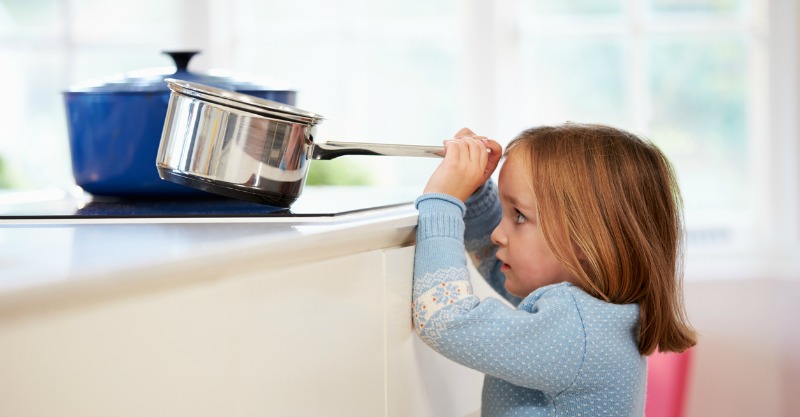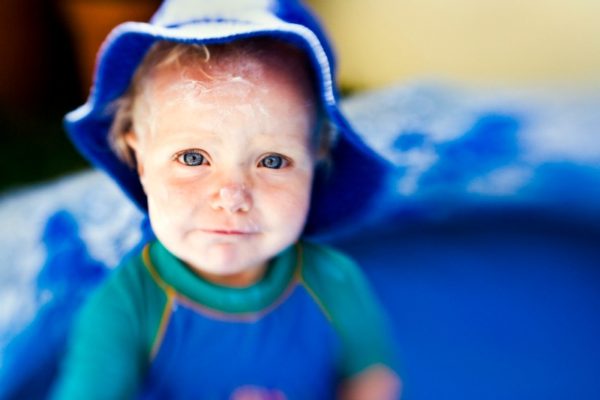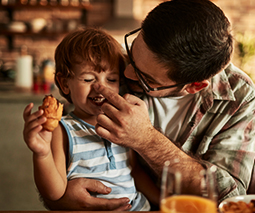The most common causes of childhood burns and how to treat them

The home can be a dangerous place for little ones, with accidental burns or scalds posing one of the greatest threats. Children aged of four and under are the most at risk, yet in most cases these incidents are preventable.
A hazardous home
There are many different ways that a small child can burn themselves around the house, therefore it’s important to be aware of the risks. These are the most common hazards to be aware of:
- Scalds from hot bath water, steam, hot foods, cooking oils and spilled hot drinks.
- Direct contact burns from the stove, fireplace, an iron or a candle flame.
- Chemical burns from when the skin comes into contact with chemicals like bleach or oven cleaner.
- Electrical burns caused by sticking items into light sockets or biting on cords.
- Sunburn caused by overexposure to the sun which can be very harmful to young, sensitive skin.
Types of burns
Over 1,000 children in Australia are hospitalised each year with burn injuries. While all cases should be treated immediately, it’s important to know the difference between the three degrees of burns to help assess whether urgent medical attention is required. A quick summary is as follows:
- First-degree burns: Damage the top layer of skin only. Skin will be dry and red with some pain and minor swelling and will heal in around three to six days.
- Second-degree burns: Go deeper to damage the first layer of skin and results in blisters, red marks and severe pain. Healing time can be three weeks or more.
- Third-degree burns: This is the most serious burn as it damages each layer of skin and the tissue underneath. Skin will look dry, leathery, brown, white or charred and there may not be much pain initially due to nerve damage. Healing can take a long time with treatment such as skin grafts often required.

What to do
There’s still a lot of confusion out there around burns (thanks to things likes of dangerous old wives’ tales), so it’s vital to know the correct procedures if one occurs. In the event of your child suffering a burn here’s what you should do:
General advice
- Act quickly to cool down the area of the burn and help reduce further damage by running it under cool water.
- Call 000 if you think your child has a second or third-degree burn, a burn that covers more than 10 percent of their body, an open flame burn, chemical or electrical burn, if the burn is on the face, scalp, hands, joints or genitals, or if it looks infected (pus, swelling, etc.).
First-degree burns
- Run cool (not cold) water over the area for 10-15 minutes
- Remove your child from the heat source and their clothing surrounding the burn
- Place a wet cloth over the affected area
- DO NOT put ice or other remedies on the burn such as butter
- Apply aloe gel or cream to the burn
- Give your child pain relief such as ibuprofen
- Keep the burn clean with a bandage
Second and third-degree burns
- Call 000 and follow the same instructions for first-degree burns
- Lie your child down and keep the area that’s burned elevated
- Remove clothing and jewellery around the burn, except for anything that’s stuck to the skin
- Don’t break any blisters
Fire, electrical and chemical burns
- Get your child to roll on the ground to put out any flames and cover them with a blanket or jacket
- If electrical, don’t touch your child until they’re not in contact with the electrical source or you may get shocked
- Flush chemical burns with lots of running water and don’t remove clothes until you’ve begun this process
- Call the Poisons Centre hotline on 13 11 26 if you believe your child has swallowed something like a battery or chemicals
- Be mindful that chemical and electrical burns often don’t look very serious but can do internal damage

How to prevent burns
Of course accidents do happen when curious children are about, no matter how diligent you are, but here are some tips to help reduce the chances of your little one being burned around the home:
- Keep matches, lighters, lit candles, chemicals out of children’s reach
- Turn pot handles away from the edge of the stove when you cook
- Never hold children while cooking
- Keep hot drinks and food out of kids’ reach and avoid using tablecloths or mats which can be pulled down
- Never drink hot drinks or soups with children on your lap or carry them near kids
- Don’t heat up formula or breast milk in the microwave as it may heat unevenly and scald your baby’s mouth
- Always test your child’s bath water with your elbow first
- Put child-proof covers on all electrical sockets
- Always turn tap faucets to cold water before turning them off
- Discard any appliances with damaged or old cords
- Use cool-mist vaporisers or humidifiers rather than hot-steam ones
- Never leave items like hot irons or hair straighteners unattended while using or within reach once cooling down
- Don’t smoke in the house
- Screen fireplaces, wood-burning stoves and possibly radiators and electric heaters also
- Make sure children wear sleepwear that’s labelled flame retardant
- Cover car seats, strollers and seat belts if it’s a sunny day as the vinyl and metal can heat up and cause burns
- Have a smoke alarm on every level of your house, check it regularly and change the batteries twice a year
- Apply sunscreen to your child regularly and cover up babies under six months where possible
If you’re ever unsure whether your child’s burn is serious or are concerned at all, please call 000 for assistance.









